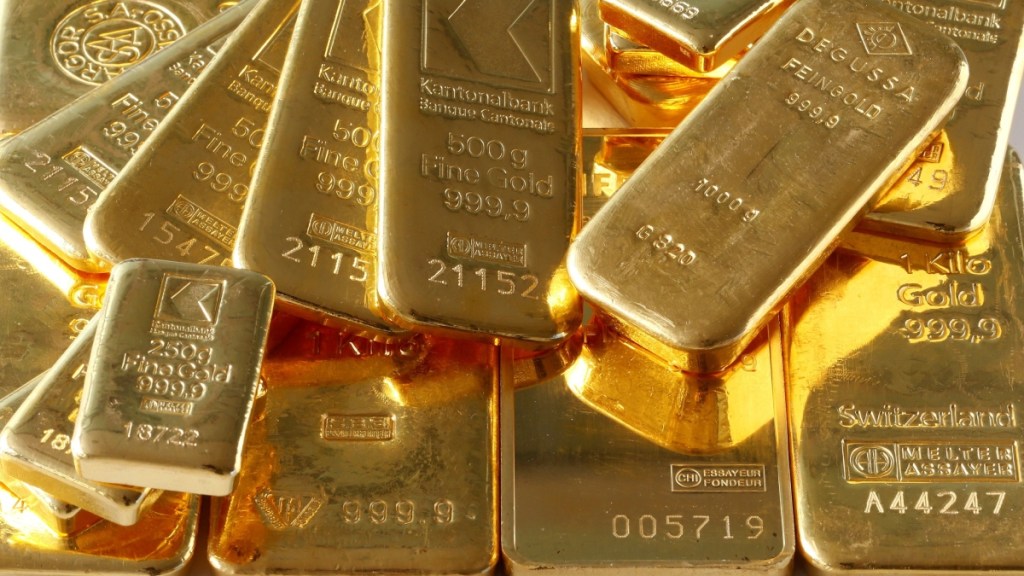Gold broke through its all-time high of $2,060 an ounce at the end of last week, and, in the process, exploded above an important trend line, as can be seen in the accompanying graphic. Since we are in uncharted territory, it is difficult to say whether this was just a flash and it will ease back down or whether it could lead to ‘blue sky’. The gold bugs, who have been remarkably quiet over the recent past, had some months ago been touting an absurd $4,000 an ounce and, more reasonably $2,100 an ounce, which is certainly within sight.
So, what’s causing this wild ride?
Historically, gold and the dollar had an inverse relationship, and gold shooting up would sometimes be an early signal of a dollar decline. Between 2002 and 2016, the DXY and gold had an inverse correlation 85% of the time; since 2016, however, this negative correlation has fallen to 73%, indicating that the link has weakened. Some analysts see the current gold surge as a sign that the dollar may collapse—and while that may still happen, my sense is that there are some other elements at play.
Another argument is that gold rises as a store of value when other investment avenues become less attractive. Currently, US equities are rocking as the US economy continues to show strength despite higher interest rates; also, the market believes that the Fed has reached the end of its tightening cycle and has successfully created a “soft landing”. This belief is also making bonds attractive, with many investors expecting US rates to be, perhaps, 1% lower next year. Thus, the two largest markets in the world are certainly not in difficult shape, refuting this as a reason for gold’s rise.
Again, gold often rises because of safe-haven buying in times of geopolitical trauma. It is true that it shot above $2,000 an ounce for the first time ever on March 9, 2022—about two weeks after Russia’s invasion of Ukraine. But gold was at $1,950 right before the invasion; so, it wasn’t a huge jump, and, in any case, the price fell back to $1,900 in a week after that.
However, the geopolitical fallout of the invasion—sanctions on trading with Russia and, importantly, blocking Russian banks from SWIFT, the global (but American-owned) financial settlement system—triggered some far-reaching moves, with several countries, particularly China, accelerating some earlier tentative moves to insulate themselves from the US’s hegemony over global financial markets.
Back in 2017, the Peoples’ Bank of China and the Central Bank of Russia signed a memorandum to facilitate the exchange of crude oil using yuan—the petro yuan—and in March 2018, the Chinese government issued the first long-term oil trading contracts denominated in yuan. Since then the Chinese central bank has been buying gold steadily with the goal of having at least 5% of its huge foreign currency reserves (nearly $3.2 trillion) in gold. I note that gold was quiet, though volatile, in the $1,200-1,400 range since 2013, till it broke out upwards around 2019 and hasn’t looked back since. This could have been the result of China’s steady buying since 2018.
It is clear that China as well as Russia and some other oil producers, like Venezuela and Iran, have been looking for a way to shake off the yoke of the petrodollar for some time. And on the sell side, the OPEC and Saudi Arabia would also be keen on finding ways around dollar hegemony which brings them under pressure to conform to US policy.
Now, China is the biggest global buyer of oil, importing nearly 600 million tonnes of crude (nearly $400 billion) a year. Since 2022, China has been in talks with Saudi Arabia to sell them oil in yuan. It is possible that the Saudis may have asked for the yuan to be backed by gold, to bolster its lack of free convertibility. This could explain why the Chinese central bank has been buying more and more gold each year. Interestingly, China has a very low share of gold in its reserves (3.84% in Q2 2023)—indeed, the lowest of the top 20 central bank gold holders. Many countries with freely convertible currencies—the US, EU countries—have a huge (more than 60%) share of gold in their reserves; this makes sense since they really don’t need to hold large reserves since their currencies are freely convertible. For China which has a non-convertible currency and a loudly articulated agenda to globalise its currency, increasing its gold holdings to provide backing to its currency in global trade seems like an obvious move.
Given that China has already announced its goal of raising gold holdings to 5%; the fact that even at $2,050, gold has only risen by $100 from the end of Q2 2023 (when the share of China’s gold holdings was 3.84%); and the possibility that China may see fit to push the share of its gold holdings even higher than 5%, we may well be seeing just the start of a real bull market in gold.
The author is the CEO of Mecklai Financial. Views are personal

